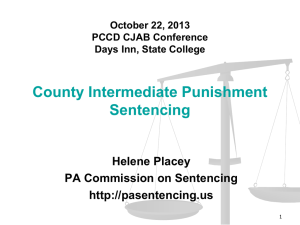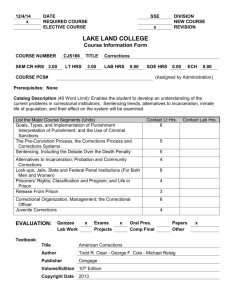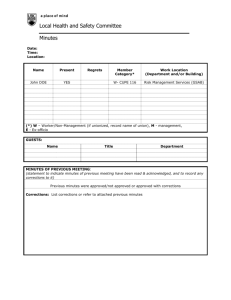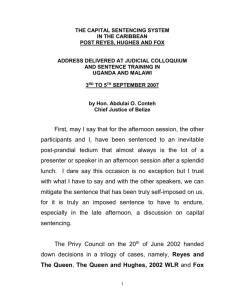Sentencing & Correctional Issues
advertisement
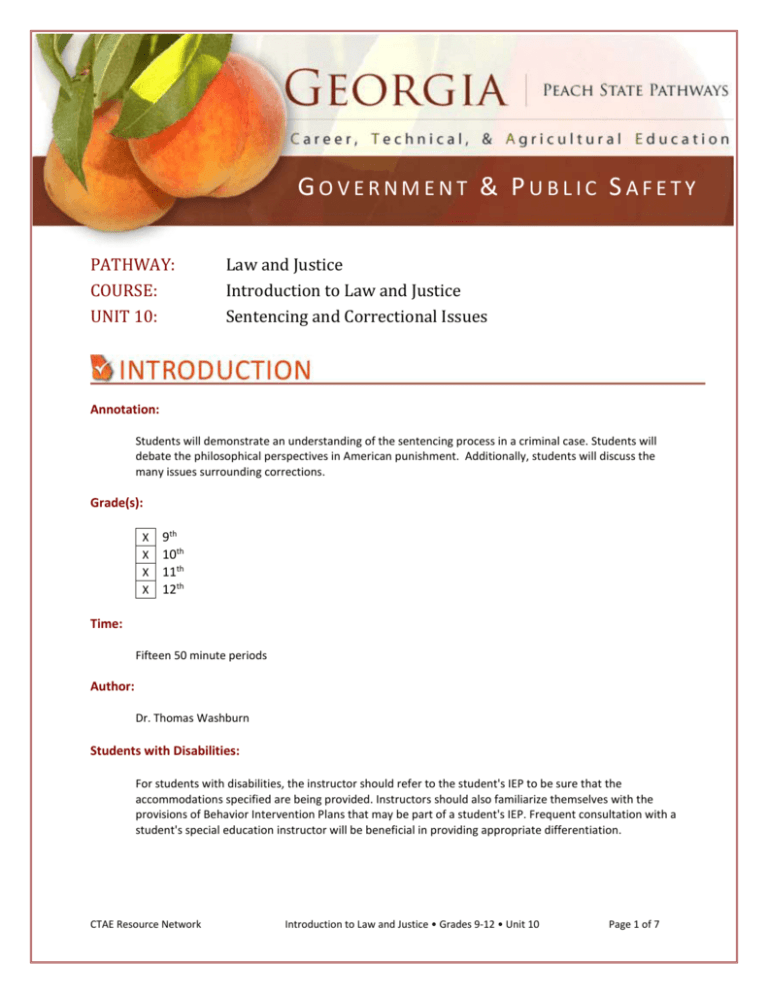
GOVERNMENT & PUBLIC SAFETY PATHWAY: COURSE: UNIT 10: Law and Justice Introduction to Law and Justice Sentencing and Correctional Issues Annotation: Students will demonstrate an understanding of the sentencing process in a criminal case. Students will debate the philosophical perspectives in American punishment. Additionally, students will discuss the many issues surrounding corrections. Grade(s): X X X X 9th 10th 11th 12th Time: Fifteen 50 minute periods Author: Dr. Thomas Washburn Students with Disabilities: For students with disabilities, the instructor should refer to the student's IEP to be sure that the accommodations specified are being provided. Instructors should also familiarize themselves with the provisions of Behavior Intervention Plans that may be part of a student's IEP. Frequent consultation with a student's special education instructor will be beneficial in providing appropriate differentiation. CTAE Resource Network Introduction to Law and Justice • Grades 9-12 • Unit 10 Page 1 of 7 GPS Focus Standards: PS-ILJ-15 Students will explain the various purposes and different types of incarceration sentences. a) Identify the general factors influencing a judge’s sentencing decision. b) Describe how judges vary sentences to fit the crime and offender. c) Explain the three basic types of sentences. d) Understand the rationales or justifications for criminal punishment. e) Explain the purposes of pre-sentence investigation reports. f) Summarize the arguments in support of and in opposition to the Three Strikes Law. PS-ILJ-16 Students will describe American corrections. a) Describe correctional officer duties. b) Explain how today’s inmate society differs from those of the past. c) Identify prisoners’ rights. d) Explain methods of inmate release. e) Summarize what recidivism research reveals about the success of the prison in achieving deterrence and rehabilitation. f) Identify the circumstances for which capitol punishment might be applied. g) Debate issues related to capital punishment. GPS Academic Standards: SSCG16 SSCG22 SSUSH24 ELA10RC2 ELA12LSV1 ELA12W1 ELA12W3 ELA12C1 SSCG22 The student will demonstrate knowledge of the operation of the federal judiciary. The student will demonstrate knowledge of the criminal justice process. The student will analyze the impact of social change movements and organizations of the 1960s. The student participates in discussions related to curricular learning in all subject areas. The student participates in student-to-teacher, student-to-student, and group verbal interactions. The student produces writing that establishes an appropriate organizational structure, sets a context and engages the reader, maintains a coherent focus throughout, and signals a satisfying closure. The student uses research and technology to support writing. The student demonstrates understanding and control of the rules of the English language, realizing that usage involves the appropriate application of conventions and grammar in both written and spoken formats. The student will demonstrate knowledge of the criminal justice process National / Local Standards / Industry / ISTE: Law, Public Safety, and Security Career Cluster Law Enforcement Pathway Knowledge and Skill Statements: Demonstrate knowledge and understanding of the U.S. legal system and the implications for law enforcement services. CTAE Resource Network Introduction to Law and Justice • Grades 9-12 • Unit 10 Page 2 of 7 Enduring Understandings: History has profound influence in American Corrections. The death penalty is an expensive and litigious process. There a several common rationales for criminal punishment that justify the way corrections programs are administered. Essential Questions: • What issues affect the courts’ decisions when sentencing defendants? Knowledge from this Unit: Students will: • Assess factors influencing sentencing by judges. • Defend a correctional philosophical rationale. • Grade the effectiveness of mandatory sentencing. • Recommend correctional programs based upon recidivism research. Skills from this Unit: Students will: • Formulate arguments in favor or opposition of the death penalty. • Critique a government action in a correctional program as it applies to Constitutional standards. Assessment Method Type: x Pre-test Objective assessment - multiple-choice, true- false, etc. __ Quizzes/Tests _x_ Unit test x Group project Individual project Self-assessment - May include practice quizzes, games, simulations, checklists, etc. __ Self-check rubrics __ Self-check during writing/planning process __ Journal reflections on concepts, personal experiences and impact on one’s life __ Reflect on evaluations of work from teachers, business partners, and competition judges __ Academic prompts __ Practice quizzes/tests x Subjective assessment/Informal observations __ Essay tests __ Observe students working with partners __ Observe students role playing Peer-assessment __ Peer editing & commentary of products/projects/presentations using rubrics __ Peer editing and/or critiquing CTAE Resource Network Introduction to Law and Justice • Grades 9-12 • Unit 10 Page 3 of 7 x Dialogue and Discussion __ Student/teacher conferences _x_ Partner and small group discussions _x_ Whole group discussions __ Interaction with/feedback from community members/speakers and business partners Constructed Responses __ Chart good reading/writing/listening/speaking habits __ Application of skills to real-life situations/scenarios Post-test Assessment Attachments and / or Directions: Unit test for Sentencing and Correctional Issues: Files included are the keys, reviews, answer sheet and test. The answer sheet is designed to allow the instructor to cut out the correct answers and lay the key over the student submitted sheet. Then using a highlighter the instructor can identify wrong answers. It allows for speedy grading and provides the student with the correct answer on questions they got wrong. ILJ_9_Test 12 - Sentencing & Corrections ILJ_9_Test 12 - Sentencing & Corrections– Answer ILJ_9_Test 12 - Sentencing & Corrections– Answer Key ILJ_9_Test 12 - Sentencing & Corrections– Key ILJ_9_Test 12 - Sentencing & Corrections– review • LESSON 1: SENTENCING AND CORRECTIONS 1. Identify the standards. Standards should be posted in the classroom. PS-ILJ-15 Students will explain the various purposes and different types of sentences. a) Identify the general factors influencing a judge’s sentencing decision. b) Describe how judges vary sentences to fit the crime and offender. c) Explain the three basic types of sentences. d) Understand the rationales or justifications for criminal punishment. e) Explain the purposes of pre-sentence investigation reports. f) Summarize the arguments in support of and in opposition to the Three Strikes Law. PS-ILJ-16 Students will describe American corrections. a) Describe correctional officer duties. b) Explain how today’s inmate society differs from those of the past. c) Identify prisoners’ rights. d) Explain methods of inmate release. e) Summarize what recidivism research reveals about the success of the prison in achieving deterrence and rehabilitation. f) Identify the circumstances for which capitol punishment might be applied. g) Debate issues related to capital punishment. 2. Review Essential Question(s). Post Essential Questions in the classroom. EQ: What issues effect the courts’ decisions when sentencing defendants? CTAE Resource Network Introduction to Law and Justice • Grades 9-12 • Unit 10 Page 4 of 7 3. Identify and review the unit vocabulary. Terms may be posted on word wall. Indeterminate Sentencing Deterrence Pre-Sentence Investigation Reports Bifurcated Trials 4. Just Desserts Retribution Restoration Statutory Provisions Incapacitation Determinate Sentencing Pardon Interest approach Show the documentary Angola: The Farm (1998). Show at least through the part where the new inmates are given an orientation lecture from the older inmate. As with all movies, note the MPAA rating to determine the appropriateness for classroom use. Then discuss: • Think about being 18 years old and realizing you are going to never leave the walls of Angola. • Think about what the older inmates tell the younger guys – that all your friends and family will slowly fade away – how would that make you feel? • What would be the worst thing about prison? You could show the rest of the video at this point. 5. Assign the Debate/Discussion research on “three strikes” laws and capital punishment found in ILJ_10_Assignment Log - Sentencing & Corrections 6. Assign Reading Notes for relevant chapters in the text. Reading notes were explained in ILJ_2 lesson plans. 7. Lecture from MS PowerPoint for Sentencing and Correctional Issues a. Use guided notes for students to follow along with as you lecture 8. Debate “three strikes” laws. Have students refer to their research that was assigned. Look for class debate tips in the web links. 9. Debate capital punishment. Have students refer to their research that was assigned. 10. Have students read Machines of Death from Popular Mechanics January 1998. There is a worksheet for them to fill out ILJ_10_Machines of Death. The information is very accurate and de-mystifies the methods used. 11. Arrange a field trip to your local prison. Currently tours are only being done at the Diagnostic Prison at Jackson due to budget cuts. Jackson is a great place to tour as students get to see the death chamber. However, tours are limited and are assigned to first come, first served. Check the correctional department website for details. Currently the state offers reimbursement for the bus driver. 12. Show media that encourages student reflection on jail and prison issues. The 1996 ABC Prime Time Live Judgment at Midnight is outstanding in showing the last days of a condemned man as is still available for purchase. Some of the newer prison reality-type programs are a bit too sensational, but may be useful for your purposes. • ATTACHMENTS FOR LESSON PLANS • • ILJ_10_Assignment Log - Sentencing & Corrections ILJ_10_Daily Outline - Sentencing & Corrections CTAE Resource Network Introduction to Law and Justice • Grades 9-12 • Unit 10 Page 5 of 7 • • • • • • • • • • • • ILJ_10_Essential Question - Sentencing & Corrections ILJ_10_Instructor Notes - Sentencing & Corrections ILJ_10_Machines of Death (MSWord) ILJ_10_Machines of Death (pdf) ILJ_10_Review Game Sentencing (note: this file and the following wav files must be in the same folder for the game show to work properly) o Lets Play Theme (wav file) o New Question (wav file) o Regis Walks In (wav file) o Value of Next Question (wav file) o Who Wants to Be a Millionaire (wav file) ILJ_10_Sentencing & Correctional Issues ILJ_10_Sentencing Guidelines ILJ_10_Sentencing Guidelines Manual ILJ_10_Student Notes - Sentencing & Corrections ILJ_10_The Farm-Angola ILJ_10_Unit Wall Poster - Sentencing & Corrections ILJ_10_Word Wall - Sentencing & Corrections • NOTES & REFLECTION: This can be a very interesting unit for the students. It is important to dispel many myths about corrections. Students perceive that prisons are out of control due to portrayals on TV – but in fact prisons in Georgia are run very tightly. This unit is also a great place to implement cross-curricular integration with reading, debate, research, and other language arts type assignments. If you can successfully implement a classroom debate in this unit – the rules you establish will serve you for the remaining courses. There is much room in this section for discussion/debate on topics the students should be motivated to form opinions about. It is a great place to teach them how to conduct themselves. Culminating Unit Performance Task Title: Correctional Issues Think Tank Culminating Unit Performance Task Description/Directions/Differentiated Instruction: Group students into groups of three or four. Tell them that they are a correctional think tank (you may need to explain what a think tank is) and that they are to advise the new governor or president (which ever you choose) of the three most critical changes that need to be made to the corrections in our state or nation. They are to substantiate their choices with facts, supporting justification, and be prepared to defend their choices. Then have a classroom “board meeting” where the class considers all the groups suggestions and choose the final three changes the think tank will present to the governor/president. You can evaluate teams for participation and then have students evaluate each other in a peer evaluation form. CTAE Resource Network Introduction to Law and Justice • Grades 9-12 • Unit 10 Page 6 of 7 Attachments for Culminating Performance Task: • • ILJ_10_Think Tank Group Evaluation ILJ_10_Participation Rubric Web Resources: • • • • • • • www.insideprison.com www.schr.org www.dcor.state.ga.us www.bop.gov www.deathpenaltyinfo.org www.educationworld.com/a_lesson/lesson/lesson304b.shtml www.helium.com/items/1157601-class-debates-tips-on-class-debates-teachers-and-debatesdebating-school-debates abcnewsstore.go.com/webapp/wcs/stores/servlet/DSIProductDisplay?catalogId=11002&storeId=200 51&productId=2010619&langId=-1&categoryId=100024 www46.homepage.villanova.edu/john.immerwahr/TP101/lects/participation%20matrix0001.pdf en.wikipedia.org/wiki/The_Farm_(film) • • Materials & Equipment: • • • • Computer Projector/TV VHS/DVD for media Prizes for winning game show team 21st Century Technology Used: x Slide Show Software Interactive Whiteboard Student Response System Web Design Software Animation Software Email CTAE Resource Network x Graphing Software Calculator Desktop Publishing Blog Wiki Website x x x Audio File(s) Graphic Organizer Image File(s) Video Electronic Game or Puzzle Maker Introduction to Law and Justice • Grades 9-12 • Unit 10 Page 7 of 7



